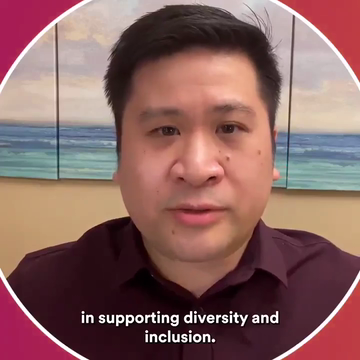3M Celebrates Asian American Pacific Islander (AAPI) Heritage Month
Originally published on 3M News Center
3M is celebrating Asian American Pacific Islander (AAPI) Heritage Month in May – a time to pay special tribute to generations of people who have enriched our world and who are instrumental to our future success.
Diversity is one of 3M’s core company priorities. Bringing different cultures, nationalities, backgrounds, insights and abilities to everything we do allows us to harness the power of our people to meet the needs of our customers around the world – while also striving to provide a supportive and fulfilling environment for all our employees.
At 3M, we celebrate our vibrant community of AAPI employees by learning how we can continue to lift up our AAPI colleagues, friends and communities.
Asian Americans Pacific Islanders represent a broad and diverse group of people with roots in more than 40 countries, but they share a culture that celebrates community and the value of the collective.
To celebrate AAPI Heritage Month, here’s a look at five things you can do in support of AAPI friends, colleagues and communities.
Be an ally
Nisha Bhaskara, whose heritage is Indian:
“To be an ally, you must constantly educate yourself and be there for your colleagues and peers. During the pandemic, when Asians were experiencing attacks in the U.S., I reached out to a friend who is Chinese and found out she was afraid to leave her house for months. It shook me and I wish I had reached out to her earlier. Keep the conversation going even if you must step out of your comfort zone and ask difficult questions. Having friends and co-workers who are strong supporters can make a big difference when they are going through a difficult time.”
Allies, mentors and sponsors can make meaningful interventions whether large or small, according to the Harvard Business Review article “What Does it Mean to Be a True Ally to Women of Color?”
Advocate for new opportunities
Victoria Png, who was born in the U.S. and whose heritage is Chinese Malaysian:
“Be intentional when advocating for growth or leadership opportunities for diverse candidates. Give them valuable experiences they can utilize as part of their professional and personal growth.”
Harvard Business Review explored a study in Silicon Valley showing that white men and women were 154 percent more likely than Asians to hold an executive role in the article Why Aren’t There More Asian Americans in Leadership Positions? Part of the reason may be due to stereotypes but also to a culture where humility and deference are more valued compared to Western cultures, according to the report.
Recognize cultural differences
Yoojung Bao, whose heritage is South Korean:
“Having been born and raised in Korea, I grew up watching my mom take on most of the household responsibilities. She looked after me and my brother as well as my grandparents, while setting aside her career and her passion for other things. Although things are changing, it is still a cultural expectation in many Asian households that women are responsible for taking care of family. For example, a lot of women in Korea quit their jobs to care for their children and help with their education.”
According to a McKinsey report, women are under-represented in top management, and at all levels, in Asia Pacific. This partially stems from the cultural expectation on women to prioritize caring for family over paid work.
Consider how your organization can help support, foster and champion leadership opportunities for Asian women while being mindful of cultural differences and responsibilities.
Learn about cross-cultural communication
Eileen Tsai, whose heritage is Japanese, Chinese and Taiwanese:
“I grew up in Japan, Taiwan and San Francisco and I’ve experienced cross-cultural communications in multiple settings. How to appropriately greet, speak and listen in a family setting or a diverse business setting can be challenging yet energizing. I proactively encourage being open-minded, empowering others by asking open-ended questions and by actively listening. It is important to facilitate mindful conversation to become more culturally and self-aware.”
In Asian cultures, hierarchy can play an important role. Understanding cultural backgrounds can help govern how we communicate and interact within a team. According to this article “3 Situations Where Cross-Cultural Communication Breaks Down” (hbr.org), members of more individualistic countries are accustomed to voicing unfiltered opinions and ideas, while those from hierarchical countries may hesitate to contribute until a leader has spoken. The fix? When asking for team input, be sure to directly ask each person for their view individually.
Understand the Asian diaspora and support the community
Paula Zaretzky, who was born in China but adopted by a white American single mother:
“No two people have the same experience, and the best way to support the community is to understand that there is a huge diversity in heritages and also reasons that people are where they are today. Ask mindful questions, educate yourself, and stand up for the community.”
Merriam Webster Dictionary defines “diaspora” as people settled far from their ancestral homelands or the movement, migration, or scattering of a people away from an established or ancestral homeland.
The Asian diaspora encompasses many experiences. There are many homelands and many reasons for leaving. Asia is the largest continent in the world, with rich geographic and cultural diversity between those homelands – from China to India, Syria to Kazakhstan, Sri Lanka to Laos, Singapore to Afghanistan, and Iran to Vietnam. The reasons people leave can range from seeking asylum or refugee status to opportunities for higher education opportunities. Other people are removed from their homeland through international adoption. This lens of the Asian diaspora is perhaps less known but is in no way less important.
Asian people whose parents or grandparents immigrated to the United States have different experiences and relationships to their culture than those who are currently first-generation immigrants. And these groups have different experiences than those who were born in their homeland but raised in the United States by people who are not of the same heritage.
Learn about the variety of ways you can help to educate yourself and support AAPI communities.



